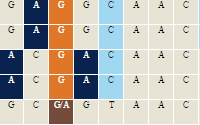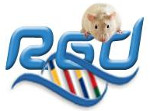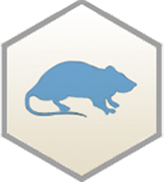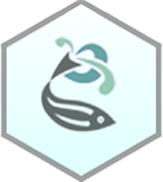Tbc1d15
(Rattus norvegicus - Norway rat) |
| Rat Assembly | Chr | Position (strand) | Source | Genome Browsers |
|---|
| JBrowse | NCBI | UCSC | Ensembl |
|---|
GRCr8 | 7 | 52,690,770 - 52,746,309 (-) | NCBI | GRCr8 | GRCr8 | | GRCr8 | GRCr8 Ensembl | 7 | 52,690,770 - 52,746,303 (-) | Ensembl | | | | GRCr8 | mRatBN7.2 | 7 | 50,804,553 - 50,860,272 (-) | NCBI | mRatBN7.2 | mRatBN7.2 | | | mRatBN7.2 Ensembl | 7 | 50,804,012 - 50,860,175 (-) | Ensembl | | | | mRatBN7.2 | Rnor_6.0 | 7 | 58,164,190 - 58,219,804 (-) | NCBI | Rnor_6.0 | Rnor_6.0 | rn6 | Rnor6.0 | Rnor_6.0 Ensembl | 7 | 58,164,198 - 58,219,790 (-) | Ensembl | | | rn6 | Rnor6.0 | Rnor_5.0 | 7 | 58,173,077 - 58,228,703 (-) | NCBI | Rnor_5.0 | Rnor_5.0 | rn5 | | RGSC_v3.4 | 7 | 54,445,319 - 54,504,473 (-) | NCBI | RGSC_v3.4 | RGSC_v3.4 | rn4 | | Celera | 7 | 47,597,371 - 47,652,320 (-) | NCBI | | Celera | | | RGSC_v3.1 | 7 | 54,466,468 - 54,525,075 (-) | NCBI | | | | | Cytogenetic Map | 7 | q22 | NCBI | | | | |
|
TBC1D15
(Homo sapiens - human) |
| Human Assembly | Chr | Position (strand) | Source | Genome Browsers |
|---|
| JBrowse | NCBI | UCSC | Ensembl |
|---|
GRCh38 | 12 | 71,839,759 - 71,924,313 (+) | NCBI | GRCh38 | GRCh38 | hg38 | GRCh38 | GRCh38.p14 Ensembl | 12 | 71,839,707 - 71,927,248 (+) | Ensembl | | | hg38 | GRCh38 | GRCh37 | 12 | 72,233,539 - 72,318,093 (+) | NCBI | GRCh37 | GRCh37 | hg19 | GRCh37 | Build 36 | 12 | 70,519,806 - 70,604,364 (+) | NCBI | Build 36 | Build 36 | hg18 | NCBI36 | Build 34 | 12 | 70,519,805 - 70,604,362 | NCBI | | | | | Celera | 12 | 71,896,776 - 71,983,914 (+) | NCBI | | Celera | | | Cytogenetic Map | 12 | q21.1 | NCBI | | | | | HuRef | 12 | 69,283,328 - 69,370,238 (+) | NCBI | | HuRef | | | CHM1_1 | 12 | 72,200,619 - 72,287,783 (+) | NCBI | | CHM1_1 | | | T2T-CHM13v2.0 | 12 | 71,817,237 - 71,901,791 (+) | NCBI | | T2T-CHM13v2.0 | | |
|
Tbc1d15
(Mus musculus - house mouse) |
| Mouse Assembly | Chr | Position (strand) | Source | Genome Browsers |
|---|
| JBrowse | NCBI | UCSC | Ensembl |
|---|
GRCm39 | 10 | 115,031,459 - 115,087,343 (-) | NCBI | GRCm39 | GRCm39 | mm39 | | GRCm39 Ensembl | 10 | 115,033,777 - 115,087,372 (-) | Ensembl | | GRCm39 Ensembl | | GRCm39 | GRCm38 | 10 | 115,197,871 - 115,251,493 (-) | NCBI | GRCm38 | GRCm38 | mm10 | GRCm38 | GRCm38.p6 Ensembl | 10 | 115,197,872 - 115,251,467 (-) | Ensembl | | | mm10 | GRCm38 | MGSCv37 | 10 | 114,634,927 - 114,688,549 (-) | NCBI | MGSCv37 | MGSCv37 | mm9 | NCBIm37 | MGSCv36 | 10 | 114,602,568 - 114,655,575 (-) | NCBI | | MGSCv36 | mm8 | | Celera | 10 | 117,126,897 - 117,180,707 (-) | NCBI | | Celera | | | Cytogenetic Map | 10 | D2 | NCBI | | | | | cM Map | 10 | 63.51 | NCBI | | | | |
|
Tbc1d15
(Chinchilla lanigera - long-tailed chinchilla) |
| Chinchilla Assembly | Chr | Position (strand) | Source | Genome Browsers |
|---|
| JBrowse | NCBI | UCSC | Ensembl |
|---|
ChiLan1.0 Ensembl | NW_004955405 | 11,821,272 - 11,876,133 (+) | Ensembl | | | | | ChiLan1.0 | NW_004955405 | 11,821,601 - 11,876,133 (+) | NCBI | ChiLan1.0 | ChiLan1.0 | | |
|
TBC1D15
(Pan paniscus - bonobo/pygmy chimpanzee) |
| Bonobo Assembly | Chr | Position (strand) | Source | Genome Browsers |
|---|
| JBrowse | NCBI | UCSC | Ensembl |
|---|
NHGRI_mPanPan1-v2 | 10 | 79,867,684 - 79,952,307 (+) | NCBI | | NHGRI_mPanPan1-v2 | | | NHGRI_mPanPan1 | 12 | 79,864,087 - 79,950,264 (+) | NCBI | | NHGRI_mPanPan1 | | | Mhudiblu_PPA_v0 | 12 | 69,362,187 - 69,446,794 (+) | NCBI | Mhudiblu_PPA_v0 | Mhudiblu_PPA_v0 | panPan3 | | PanPan1.1 | 12 | 72,220,590 - 72,304,715 (+) | NCBI | PanPan1.1 | PanPan1.1 | panPan2 | | PanPan1.1 Ensembl | 12 | 72,220,582 - 72,304,715 (+) | Ensembl | | | panPan2 | panpan1.1 |
|
TBC1D15
(Canis lupus familiaris - dog) |
| Dog Assembly | Chr | Position (strand) | Source | Genome Browsers |
|---|
| JBrowse | NCBI | UCSC | Ensembl |
|---|
CanFam3.1 | 10 | 13,357,511 - 13,426,293 (+) | NCBI | CanFam3.1 | CanFam3.1 | canFam3 | CanFam3.1 | CanFam3.1 Ensembl | 10 | 13,357,620 - 13,425,285 (+) | Ensembl | | | canFam3 | CanFam3.1 | Dog10K_Boxer_Tasha | 10 | 13,296,627 - 13,365,113 (+) | NCBI | Dog10K_Boxer_Tasha | Dog10K_Boxer_Tasha | | | ROS_Cfam_1.0 | 10 | 13,494,056 - 13,562,336 (+) | NCBI | ROS_Cfam_1.0 | ROS_Cfam_1.0 | | | ROS_Cfam_1.0 Ensembl | 10 | 13,494,147 - 13,562,622 (+) | Ensembl | | | | ROS_Cfam_1.0 Ensembl | UMICH_Zoey_3.1 | 10 | 13,355,597 - 13,423,800 (+) | NCBI | | UMICH_Zoey_3.1 | | | UNSW_CanFamBas_1.0 | 10 | 13,604,190 - 13,672,615 (+) | NCBI | | UNSW_CanFamBas_1.0 | | | UU_Cfam_GSD_1.0 | 10 | 13,727,852 - 13,796,539 (+) | NCBI | UU_Cfam_GSD_1.0 | UU_Cfam_GSD_1.0 | | |
|
Tbc1d15
(Ictidomys tridecemlineatus - thirteen-lined ground squirrel) |
|
TBC1D15
(Sus scrofa - pig) |
| Pig Assembly | Chr | Position (strand) | Source | Genome Browsers |
|---|
| JBrowse | NCBI | UCSC | Ensembl |
|---|
Sscrofa11.1 Ensembl | 5 | 35,827,473 - 35,908,385 (+) | Ensembl | | | susScr11 | Sscrofa11.1 | Sscrofa11.1 | 5 | 35,827,385 - 35,907,121 (+) | NCBI | Sscrofa11.1 | Sscrofa11.1 | susScr11 | Sscrofa11.1 | Sscrofa10.2 | 5 | 38,528,912 - 38,608,802 (+) | NCBI | Sscrofa10.2 | Sscrofa10.2 | susScr3 | |
|
TBC1D15
(Chlorocebus sabaeus - green monkey) |
| Green Monkey Assembly | Chr | Position (strand) | Source | Genome Browsers |
|---|
| JBrowse | NCBI | UCSC | Ensembl |
|---|
ChlSab1.1 | 11 | 67,472,771 - 67,554,329 (+) | NCBI | ChlSab1.1 | ChlSab1.1 | chlSab2 | | ChlSab1.1 Ensembl | 11 | 67,473,030 - 67,556,694 (+) | Ensembl | | ChlSab1.1 Ensembl | chlSab2 | Vervet-AGM | Vero_WHO_p1.0 | NW_023666037 | 178,098,752 - 178,180,097 (-) | NCBI | Vero_WHO_p1.0 | Vero_WHO_p1.0 | | |
|
Tbc1d15
(Heterocephalus glaber - naked mole-rat) |
|
Tbc1d15
(Rattus rattus - black rat) |
|











































